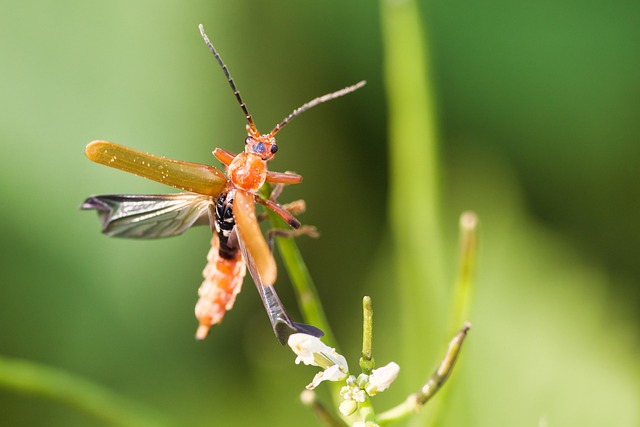Year-Round Cigarette Beetle Prevention: Comprehensive Strategies for Control
Cigarette beetles, common household pests, cause damage by infesting tobacco products and organic it…….
Cigarette Beetles Treatment: A Comprehensive Overview
Introduction
Cigarette beetles, particularly the species Lasioderma serricorne, are small insects that pose a significant threat to stored products, including tobacco and its derivatives. Infestations can lead to substantial economic losses for farmers, manufacturers, and retailers. The treatment of cigarette beetle infestations is a critical aspect of pest management in the tobacco industry. This article delves into the various strategies employed to control these pests, their global impact, economic considerations, technological advancements, regulatory frameworks, and the challenges faced. Readers will gain a comprehensive understanding of the intricacies involved in cigarette beetle treatment and its significance within the broader context of agricultural and economic systems.
Understanding Cigarette Beetles Treatment
Cigarette beetle treatment involves a combination of monitoring, identification, and application of control measures to manage infestations. The core components include the use of insecticides, non-chemical methods, and integrated pest management (IPM) strategies. Historically, treatments have evolved from reliance on broad-spectrum insecticides to more targeted, environmentally friendly approaches. Understanding the life cycle, behavior, and habitat preferences of cigarette beetles is essential for effective treatment and prevention.
Global Impact and Trends
The global impact of cigarette beetle infestations is significant, with reports of damage across various continents. The economic losses extend beyond direct damage to goods; they also include costs associated with controlling the pests, disposing of infested products, and implementing preventive measures. Key trends influencing the trajectory of cigarette beetle treatment include the rise in organic tobacco production, increased international trade, and the development of resistance to certain insecticides. Regions such as North America, Europe, and parts of Asia face varying degrees of infestation pressure, necessitating tailored treatment approaches.
Economic Considerations
Cigarette beetle treatment has substantial economic implications. The market dynamics for tobacco products are influenced by the presence or absence of pests like cigarette beetles. Investment patterns in agricultural research and development often prioritize solutions to control these pests. The role of cigarette beetle treatment in economic systems is multifaceted, affecting not only the tobacco industry but also related sectors such as storage, transportation, and trade.
Technological Advancements
Technological advancements have greatly improved the effectiveness and efficiency of cigarette beetle treatments. Innovations in detection technology, such as pheromone traps and optical sensors, enable early detection and monitoring of infestations. Biotechnology has led to the development of genetically modified crops that are resistant to pests. Additionally, advancements in thermal treatment and cold treatment technologies offer non-chemical alternatives for controlling infestations. The future potential of these technologies includes the integration of artificial intelligence and machine learning for predictive analytics and automated pest management systems.
Policy and Regulation
The policies and regulations governing cigarette beetle treatment are critical to ensuring food safety, protecting agricultural products, and maintaining trade integrity. International standards such as those set by the Codex Alimentarius provide a framework for the safe treatment of stored products, including tobacco. National regulations vary but generally include guidelines for pesticide use, import and export protocols, and quarantine measures. These frameworks influence the development and implementation of treatment strategies.
Challenges and Criticisms
Cigarette beetle treatment faces several challenges and criticisms. Pest resistance to chemical treatments is a growing concern, necessitating the development of alternative control methods. Environmental and health impacts of insecticides have led to a push for more sustainable practices. The logistical complexities of implementing treatment strategies in global supply chains add to the difficulties. Solutions to these issues include the integration of multiple control methods, the use of biopesticides, and improved monitoring and early detection systems.
Case Studies
Several case studies illustrate the successful application of cigarette beetle treatment. One notable example is the implementation of an IPM program in a major tobacco-producing country, which reduced pest damage by over 50%. Another case involves a small-scale farmer who adopted integrated pest management practices and saw a significant decrease in losses due to pests. These success stories provide valuable lessons on the practical application of treatment strategies.
Future Prospects
The future outlook for cigarette beetle treatment is promising, with potential growth areas and emerging trends that could shape its development. Innovations in molecular biology may lead to more effective and targeted biological control agents. Advances in data analytics and AI could enhance predictive models for pest outbreaks. Strategic considerations for the future include the need for international collaboration on research and monitoring, the promotion of sustainable practices, and the continuous adaptation to emerging challenges.
Conclusion
Cigarette beetle treatment is an integral part of tobacco pest management, with far-reaching economic, environmental, and social implications. The strategies employed for treatment are multifaceted and must adapt to a changing global landscape. Through technological innovation, policy support, and sustainable practices, the challenges posed by cigarette beetles can be effectively managed. As the industry continues to evolve, the commitment to finding comprehensive solutions will remain critical.
Appendix: Glossary of Key Terms
FAQ Section
Q: How do I identify a cigarette beetle infestation?
A: Cigarette beetle infestations are typically identified by the presence of adult beetles, larvae, or frass (bee-like excrement) in or around stored tobacco products. Regular inspections and monitoring using detection devices can help detect an infestation early.
Q: What are some non-chemical methods for controlling cigarette beetle populations?
A: Non-chemical methods include the use of desiccants, cold treatment, heat treatment, and biological control agents such as predators or entomopathogenic fungi. Integrated pest management (IPM) combines these methods with chemical treatments when necessary.
Q: How can I ensure my tobacco products are free from cigarette beetle damage?
A: Ensure proper storage conditions, practice good hygiene and sanitation, regularly inspect your products, use detection devices, and implement an IPM program. Adhering to regulatory standards and guidelines is also crucial for maintaining product integrity.

Cigarette beetles, common household pests, cause damage by infesting tobacco products and organic it…….

The text presents a complex set of numbers and symbols seemingly related to a puzzle or code. It dis…….

In a concise overview, this text discusses the complex interplay of various symbols and numbers, not…….

Cigarette beetles, attracted to moisture and organic materials, are persistent storage pests. Effect…….

Cigarette beetles, attracted to damp, dark spaces and organic materials, enter homes through cracks…….

Cigarette beetles, drawn to discarded cigarettes, tobacco, and wood, can cause significant damage in…….
![… [n (…) … … k. ein … … der Gruppen … … … ein … … … … … … … … … […] … … … … … … … … … … … … … … … … … … … … … … … … … … … … … … …](https://trustedstandard.com/wp-content/uploads/2025/06/cigarette-beetle-beetle-640x480-71080049.jpeg)
This text introduces eco-beetle control solutions as sustainable alternatives to chemical pesticides…….

Cigarette beetles, attracted to damp, warm environments, can cause significant wood damage in homes,…….

Cigarette beetles (Lasioartemia polybium) pose significant threats to stored products and structures…….

Cigarette beetles (Lasionella taena) are persistent pests that infest stored products, causing damag…….